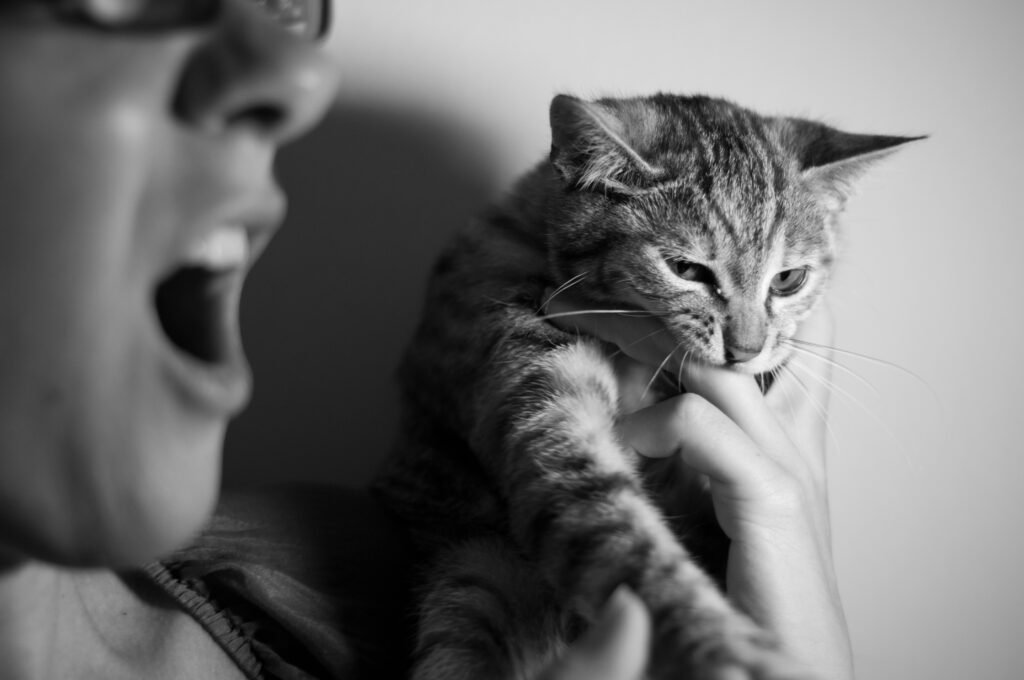Pet bites are more common than many pet owners may realize. Whether it’s a dog or a cat, bites can happen for a variety of reasons, ranging from fear and anxiety to playful aggression. To protect yourself, your family, and your pets, it’s important to understand why pets bite and what you can do to prevent such incidents.
This article delves into the causes of pet bites and provides actionable tips on bite prevention, keeping your pets safe and happy.
Why Do Pets Bite?
1. Fear and Anxiety
Fear is one of the primary reasons why pets bite. Dogs and cats often react defensively when they feel threatened or cornered. According to the American Kennel Club (AKC), dogs may bite when they are scared, startled, or protecting their territory
AVMA. Similarly, cats may bite when they feel trapped or stressed, especially during situations they can’t control, such as visits to the vet
2. Play Aggression
While dogs and cats play, they may sometimes nip or bite. This is common in puppies and kittens who haven’t yet learned bite inhibition. Playful bites aren’t typically aggressive, but they can escalate into serious incidents if not managed properly. Encouraging proper play and discouraging biting from a young age is key to preventing pet bites in the future.
3. Pain or Discomfort
Pets in pain may lash out by biting, especially if someone touches a sensitive or injured area. If your normally docile pet starts biting unexpectedly, it’s essential to rule out any health issues. Both cats and dogs might also bite when they are aging or suffering from conditions like arthritis, which cause discomfort
AVMA.
4. Protectiveness
Dogs, in particular, are protective by nature. They may bite when they believe their family, food, or toys are under threat. This type of behavior is more common in certain breeds, but any dog can exhibit protectiveness depending on the situation. According to the AVMA, pets with a history of aggression or biting are more likely to bite again, reinforcing the importance of proper training and management
AVMA.
How to Prevent Pet Bites
1. Socialization from an Early Age
One of the most effective ways to prevent pet bites is through early socialization. Introducing your dog or cat to a variety of people, environments, and other animals can help reduce anxiety and fear later in life.
Well-socialized pets are more likely to remain calm in new or challenging situations, reducing the likelihood of a bite.
Tip: Enroll your dog in puppy classes or expose them to different environments in a controlled, positive way. With cats, gradually introducing new experiences and handling them gently can make them more adaptable.
2. Avoid Sudden Movements and Rough Play
Fast movements and rough play can overstimulate pets, leading to unintended bites. Many pets, particularly dogs, have a prey drive that can be triggered by quick movements. According to Petfinder, maintaining calm energy around your pets can reduce their stress and prevent overexcitement, which can lead to biting during play
AVMA.
3. Respect Their Boundaries
Understanding your pet’s body language is crucial. Tail wagging or purring doesn’t always mean a pet is happy. In fact, pets often display subtle signs of discomfort or annoyance before they resort to biting. If a pet seems agitated or tries to escape, give them space.
Tip: Learn to read your pet’s warning signals, such as growling, flattening ears, or tensed body language. This will help prevent escalating behaviors.
4. Training and Reinforcement
Teaching pets basic commands like “sit,” “stay,” and “leave it” can be lifesaving in situations where biting might occur. Positive reinforcement, rather than punishment, encourages good behavior. The Spruce Pets emphasizes the importance of reward-based training for both dogs and cats to minimize aggressive behaviors
AVMA.
5. Use Safe Toys and Activities
Providing proper outlets for energy, especially for high-energy pets, can prevent biting behaviors caused by boredom or frustration. Offer your pet safe, durable toys that engage them mentally and physically. For example, puzzle toys for dogs and climbing structures for cats can be effective.
Recommended Products: Check out dog toys on PetSmart or cat enrichment toys on Chewy.
Bite Prevention for Specific Pets
1. Preventing Dog Bites
Dog bite prevention begins with proper training and management. Dogs are more likely to bite when they feel provoked or scared, so it’s crucial to expose them to different scenarios gradually. The AKC recommends working with a certified dog trainer to help manage any aggressive tendencies
AVMA.
2. Preventing Cat Bites
Unlike dogs, cats tend to bite when overstimulated or annoyed. Pet owners should avoid excessive petting sessions, as this can lead to unexpected bites. WebMD advises paying close attention to your cat’s body language to avoid overstimulation and resulting bites
AVMA.
What to Do If a Pet Bites?
If a pet bite occurs, it’s important to take immediate action to prevent infection. Clean the wound thoroughly with soap and water and seek medical attention, especially if the bite punctures the skin.
Pet owners should also inform their veterinarian about the incident, as it may be a sign of underlying behavioral or health issues that need to be addressed.
Treating Dog and Cat Bites
Both dog and cat bites can lead to infections, and prompt medical treatment is necessary. The American Veterinary Medical Association recommends seeking professional medical advice for any bite, especially those that break the skin
AVMA. The AVMA also advises that pets with a history of biting may require behavioral intervention or professional training to prevent future incidents.
Conclusion
Understanding the reasons behind pet bites and taking preventive steps can greatly reduce the risk of injury. Whether you have a playful puppy, a protective adult dog, or a feisty cat, being aware of their behavior and respecting their boundaries is essential.
By training, socializing, and providing proper outlets for your pet’s energy, you can ensure a harmonious and bite-free relationship with your furry companion.
Hey! do you know about pet food allergies? check out what every pet owner should understand

